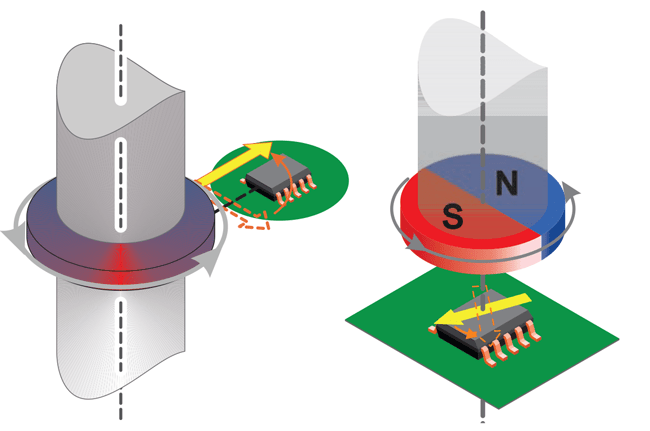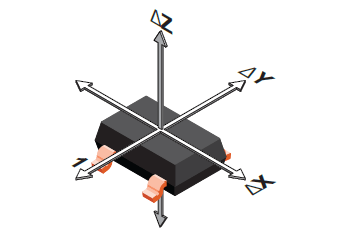Multi-Dimensional Sensing
Vertical Hall Technology
Advances in IC design and fabrication allow the creation of vertical Hall elements sensitive to magnetic fields parallel to the plane of the IC. They function under the same principles as planar Hall elements, which are sensitive only to magnetic fields perpendicular to the plane of the IC. This Z-axis sensitivity is not altered by the sensor IC orientation or rotation. As such, sensing in the plane of the PCB to which the sensor is mounted is not possible using a surface-mount device with only a planar Hall element.
Planar Hall elements are constructed across the length and width of the die (in-plane) as shown in Figure 1. Vertical Hall elements are constructed from bottom to top along the depth of the chip as shown in Figure 2.

Figure 1: Planar Hall element

Figure 2: Vertical Hall element
By rotating the IC or altering the orientation of the vertical Hall element on the die, a sensor IC can discriminate magnetic field direction as well as amplitude. An IC with more than one sensing element (see Figure 3) can sense in multiple spatial dimensions.

Figure 3: 3D Sensor IC with planar and vertical Hall sensors
There are several situations in which this can be especially useful:
- Proximity sensing in cases with large air gaps and/or the possibility of mechanical misalignment or in cases where the orientation or location of the magnet is not well defined
- Sensing the position (speed and direction) of rotating ring magnets
- Replacement of through-hole devices with smaller, lower-cost SMT devices, where in-plane sensing is required
- Non-contact linear and angular position sensing where the target may be off-axis or moving in multiple dimensions (as illustrated in this ALS31300 application note)
- Detection of magnetic tampering such as in utility meters (this article illustrates the performance advantages of a 3D vertical Hall sensor in these applications)

This logo denotes products that use Allegro's vertical Hall sensor technology
Circular Vertical Hall (CVH) Sensors
As described above, vertical Hall-effect sensors can be used to discriminate magnetic field direction as well as amplitude. When arranged in a circular array, vertical Hall elements can be used to determine the angle of the applied magnetic field. Sensor ICs integrating a circular vertical Hall (CVH) array with advanced analog and digital signal processing circuits are an elegant solution to measuring the orientation of a rotating magnetic, for example, in end-shaft or side-shaft applications (see Figures 4 and 5).

This technology is the basis for many of Allegro's angle sensor ICs. The video below contains a detailed description of the inner working of our CVH angle sensors.
